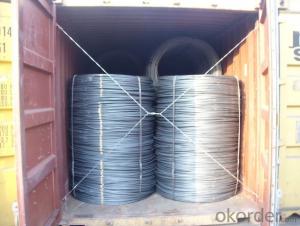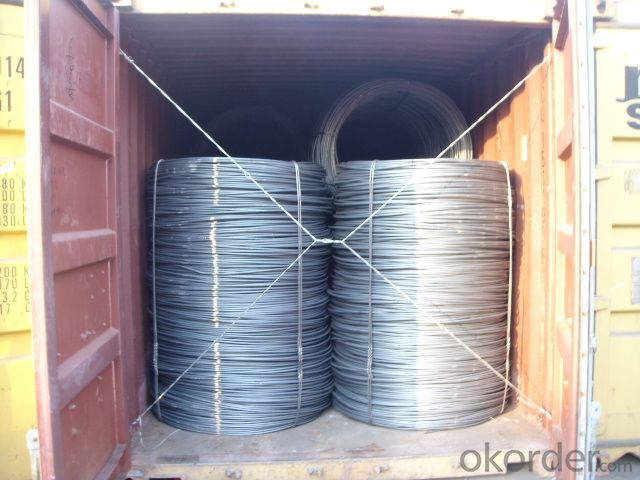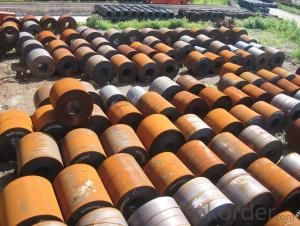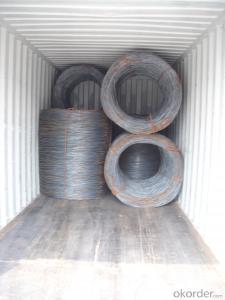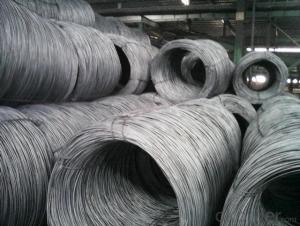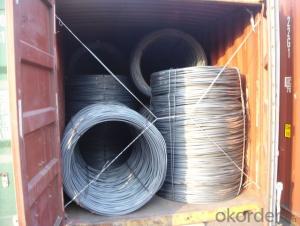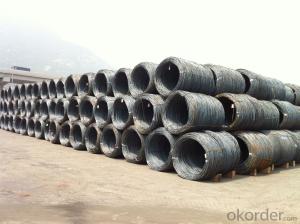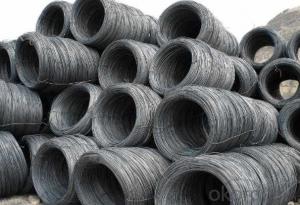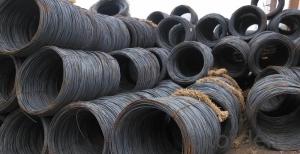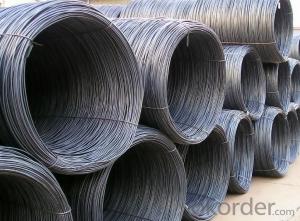GB Q195 Q235 Wire Rod
- Loading Port:
- China Main Port
- Payment Terms:
- TT OR LC
- Min Order Qty:
- -
- Supply Capability:
- -
OKorder Service Pledge
OKorder Financial Service
You Might Also Like
Specifications of Steel Wire Rod in Coil:
Steel Grade: Q195/235, SAE1006-1018B Standard: ASTM, GB
Diameter: 6.5mm
Type: Drawn Wire Alloy or Not: Alloy
Technique: Hot Rolled
Usage and Applications of Hot Rolled Wire Rod:
After hotrolled the products shaped into coil and delivery as finished product, including round, square, rectangular, hexagonal and so on. Since most of the products are round, it is generally called wire rod. Carbon steel wire rod is widely used in construction and manufacturing. Carbon steel wire rod is mainly used for reinforcement of reinforced concrete and welded structure or reprocessed (roberts , nail, etc.) materials, especially used to produce wire drawing, welding electrode, nails, spring, electronic, precise machinery parts and so on.
Packaging & Delivery of Hot Rolled Wire Rod:
Packaging Detail: products are packed in coil, each coil weight around 2 MT, and then shipped by container or bulk vessel
Delivery Detail: within 45 days after received deposit or LC.
Label: to be specified by customer, generally, each bundle has 1-2 labels
Trade terms: FOB, CFR, CIF
Note:
1. Our products are produced according to national standard (GB), if not, supply according to national standards (GB) or agreement as customer required.
2. Other Grade and Standard carbon steel wire rod we can supply:
Grade: H08A, 30MnSi, 62B-82B
Standard: AISI, BS, JIS, DIN
The Minimum Order Quantity of these products is high, and need to be confirmed.
3. We can not only supply carbon steel wire rod; if you need anything about building materials, please contact us.
4. Please send us your detail specifications when inquire. We will reply to you as soon as possible. We sincerely hope we can establish a long stable business relationship.
- Q: What are the advantages of using steel wire rod in railway applications?
- One of the main advantages of using steel wire rod in railway applications is its high tensile strength. Steel wire rod is able to withstand heavy loads and provide the necessary durability for railway tracks, ensuring safe and reliable transportation. Additionally, steel wire rod is corrosion-resistant, which is crucial in railway environments where exposure to moisture and harsh weather conditions is common. Furthermore, steel wire rod is highly versatile and can be easily manufactured into different shapes and sizes, allowing for customized solutions in railway construction and maintenance.
- Q: How is steel wire rod used in the manufacturing of piano wire?
- Steel wire rod is used as the primary material in the manufacturing of piano wire. It undergoes a series of processes, including drawing, annealing, and twisting, to create the strong and flexible strands that are then tightly wound together to form piano wire. The high tensile strength and resilience of steel wire rod make it ideal for producing piano wire, which is essential for creating the strings in pianos that produce the desired pitch and sound quality.
- Q: What are the different types of steel wire rod finishes for improved wear resistance?
- There are several types of steel wire rod finishes that can enhance wear resistance. Some of the common finishes include galvanized, zinc-coated, phosphate coated, and chrome-plated. These finishes provide an additional layer of protection to the steel wire rod, making it more resistant to wear and corrosion.
- Q: What are the strength requirements for steel wire rod used in suspension bridge wire strands?
- The strength requirements for steel wire rod used in suspension bridge wire strands can vary depending on several factors. Generally, the wire rod must possess high tensile strength to withstand the immense loads and stresses that suspension bridges are subjected to. The wire rod must have a minimum yield strength and ultimate tensile strength that meets or exceeds the design requirements for the suspension bridge. The yield strength refers to the amount of stress that the wire rod can withstand before it begins to deform permanently, while the ultimate tensile strength indicates the maximum stress the wire rod can endure before it breaks. In addition to high strength, the wire rod must also exhibit good ductility and toughness. Ductility refers to the ability of the material to deform without fracturing, while toughness is its ability to absorb energy without fracturing. These properties are crucial for structural integrity as they allow the wire strand to flex and absorb dynamic loads, such as wind or vehicle vibrations, without failure. Furthermore, the wire rod should have excellent corrosion resistance to ensure the longevity and durability of the suspension bridge. Corrosion can weaken the wire strands over time, compromising the structural integrity of the bridge. Therefore, the wire rod must possess a protective coating or be made from corrosion-resistant alloys to withstand exposure to environmental factors such as moisture, saltwater, and pollutants. Finally, the dimensional requirements of the wire rod, including its diameter and surface finish, must also meet the specifications of the suspension bridge design. These dimensions are crucial for maintaining the desired strength and performance characteristics of the wire strands. In summary, the strength requirements for steel wire rod used in suspension bridge wire strands include high tensile strength, good ductility, toughness, corrosion resistance, and adherence to dimensional specifications. Meeting these requirements ensures the wire strands can withstand the significant loads and environmental conditions experienced by suspension bridges, ensuring their structural integrity and safety.
- Q: What are the different surface defects that can impact the tensile strength of steel wire rod?
- Some of the different surface defects that can impact the tensile strength of steel wire rod include scratches, cracks, pits, and scale. These defects can weaken the structure of the wire rod and reduce its ability to withstand tension, resulting in a lower tensile strength.
- Q: What are the different testing methods for steel wire rod?
- There are several different testing methods that can be used to evaluate the quality and characteristics of steel wire rods. Some of the most common testing methods include: 1. Tensile Testing: This method involves subjecting the steel wire rod to tension until it breaks. It helps to measure the maximum load the rod can bear and provides information about its tensile strength, yield strength, and elongation. 2. Bend Testing: In this method, the steel wire rod is bent to a specific angle and examined for any cracks or fractures. It helps to assess the rod's ductility and resistance to deformation. 3. Hardness Testing: This method measures the hardness of the steel wire rod using various techniques such as Rockwell, Brinell, or Vickers hardness tests. It determines the material's ability to resist indentation or penetration. 4. Microscopic Examination: This method involves examining the microstructure of the steel wire rod under a microscope. It helps to assess the material's grain size, inclusion content, and overall quality. 5. Chemical Analysis: This method involves analyzing the chemical composition of the steel wire rod. It helps to ensure that the rod meets the required specifications and standards. 6. Ultrasonic Testing: This non-destructive testing method uses high-frequency sound waves to detect any internal flaws or defects in the steel wire rod. It helps to assess the rod's integrity and identify any potential weaknesses. 7. Dimensional Inspection: This method involves measuring the physical dimensions of the steel wire rod to ensure it meets the specified tolerances and requirements. By employing these testing methods, manufacturers and quality control personnel can ensure that steel wire rods meet the necessary standards for their intended applications.
- Q: What is a wire rod?
- There are many kinds of wire rods. Carbon steel wire rod in the low carbon steel wire rod, commonly known as cord, medium and high carbon steel wire rod commonly known as hard wire. Wire rods are mainly used for drawing billets, and can be used directly as building materials and machined into mechanical parts. Stainless steel wire rod is used for making stainless steel wire, stainless steel spring steel wire, stainless steel wire and stainless steel wire rope.
- Q: What are the common applications of high-strength steel wire rod?
- High-strength steel wire rods have a wide range of applications across various industries due to their exceptional strength and durability. Some of the common applications of high-strength steel wire rods include: 1. Automotive industry: High-strength steel wire rods are extensively used in the automotive industry for manufacturing various components such as springs, suspension systems, seat frames, and reinforcement bars. The high tensile strength of these wire rods ensures enhanced safety and stability in vehicles. 2. Construction industry: Steel wire rods find extensive use in the construction industry for reinforcement purposes. They are commonly used to strengthen concrete structures such as bridges, buildings, and highways. The high strength and ductility of these wire rods make them ideal for withstanding heavy loads and seismic forces. 3. Manufacturing industry: High-strength steel wire rods are widely used in the manufacturing industry for producing a variety of products, including cables, wire mesh, nails, screws, and fasteners. The superior strength and durability of these wire rods make them suitable for applications that require resistance to bending, twisting, and tension. 4. Aerospace industry: High-strength steel wire rods find applications in the aerospace industry for manufacturing aircraft components. They are used in the production of cables, control systems, landing gear, and engine components. The high strength-to-weight ratio of these wire rods plays a crucial role in ensuring the safety and reliability of aircraft structures. 5. Energy sector: Steel wire rods are commonly used in the energy sector for various applications. They are utilized in power transmission lines, suspension cables for bridges and power plants, and wire ropes for lifting heavy equipment. The high tensile strength and corrosion resistance of these wire rods make them suitable for withstanding the demanding conditions of the energy sector. 6. Consumer goods: High-strength steel wire rods are also used in the manufacturing of consumer goods such as furniture, appliances, and sporting equipment. They are employed in the production of springs for mattresses and chairs, wire frames for household appliances, and components for fitness equipment. The durability and reliability of these wire rods contribute to the longevity of consumer products. Overall, the common applications of high-strength steel wire rods span across industries, including automotive, construction, manufacturing, aerospace, energy, and consumer goods. Their exceptional strength, durability, and versatility make them a preferred choice for various applications where reliability and performance are crucial factors.
- Q: What are the different types of wire mesh for sieving made from steel wire rod?
- There are several different types of wire mesh for sieving that are made from steel wire rod. These types include: 1. Plain weave wire mesh: This is the most common type of wire mesh used for sieving. It is made by weaving the steel wire rods together in an over-and-under pattern, creating a square or rectangular mesh structure. Plain weave wire mesh is known for its simplicity and versatility. 2. Twill weave wire mesh: Twill weave wire mesh is similar to plain weave, but the wires are interlaced in a diagonal pattern, creating a tighter mesh structure. This type of wire mesh is often used for fine sieving applications where a higher level of precision is required. 3. Dutch weave wire mesh: Dutch weave wire mesh is made by weaving the wires in an over-and-under pattern, but with different wire diameters for the warp and weft wires. This creates a mesh with smaller openings in one direction, making it ideal for applications where fine particles need to be separated. 4. Welded wire mesh: Welded wire mesh is made by welding the intersecting points of the steel wires together, creating a strong and durable mesh structure. This type of wire mesh is commonly used for heavy-duty sieving applications, such as in construction or industrial settings. 5. Expanded metal mesh: Expanded metal mesh is made by cutting and stretching a flat sheet of steel, creating a mesh with diamond-shaped openings. This type of wire mesh is known for its strength and rigidity, making it suitable for sieving applications that require high impact resistance. Overall, the different types of wire mesh for sieving made from steel wire rod offer a range of options to suit various sieving needs, from basic to more specialized applications. The choice of wire mesh will depend on factors such as the size of the particles being sieved, the desired level of precision, and the intended use of the sieved material.
- Q: What are the different types of steel wire rod surface defects and their causes?
- There are several types of steel wire rod surface defects, including cracks, scratches, pits, and scale. These defects can be caused by various factors such as improper cooling, inadequate lubrication, improper handling, and contamination during the manufacturing process.
Send your message to us
GB Q195 Q235 Wire Rod
- Loading Port:
- China Main Port
- Payment Terms:
- TT OR LC
- Min Order Qty:
- -
- Supply Capability:
- -
OKorder Service Pledge
OKorder Financial Service
Similar products
Hot products
Hot Searches
Related keywords
